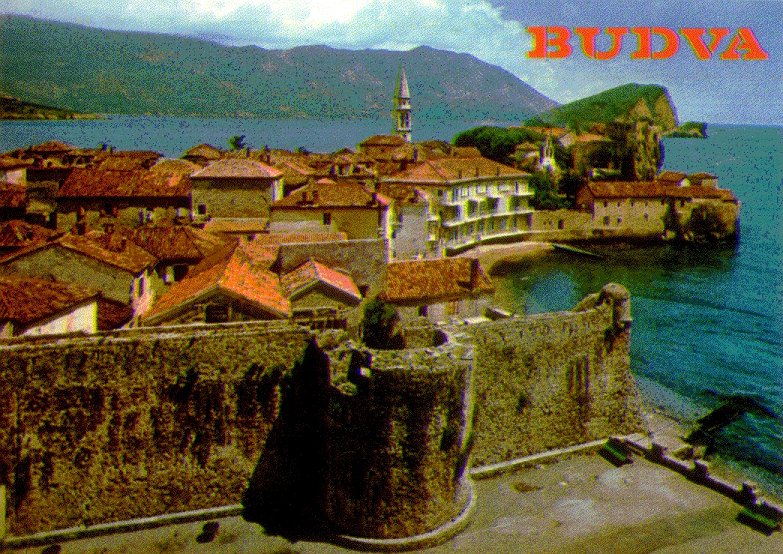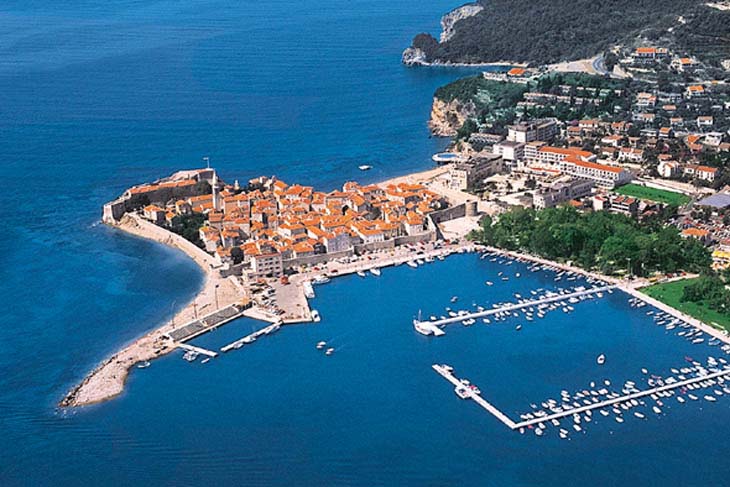Budva is the reigning "tourist capital of Montenegro" for all the right reasons. As one of the Adriatic Sea's oldest cities, Budva's 2500 year history reaches back from the past to offer you a drink on a warm sandy beach, a casual walk along lamp-lit streets, and a concert by Madonna? Yes, the 'Queen of Pop' is first scheduled to arrive in Budva in 2008, followed by other big acts in concerts sponsored by Budva's affluent city government. To explain Madonna's unusual arrival to a small town of only 16,000 inhabitants: Budva represents the two sides of Montenegro and is quickly gaining international recognition as its elegant beauty comes to grips with immense commercial promise. The foundations for Budva’s current splendor were first laid over 2500 years ago, and legend says that it all began with love! Traditional stories tell of the supreme Greek God, Zeus, who in his constant pursuit of beautiful maidens abducted the Phoenician princess Europa. As Europa’s headstrong brother, Cadmus enters the picture by seeking the advice of the all-knowing oracle at Delphi. He eventually kills a dragon, and thus commits a sin against the gods, who expel his entire family from their hometown of Thebes. In their shame, Cadmus leaves Thebes with his wife Harmonia and their children on an ox-drawn cart - the faithful ox that pulled that cart? Butoe (Budva)!
Old Town Budva -.The story regarding how Old Town Budva first got it’s name ties into a mythological tradition that spans over 2500 years, and really reflects the history found in this very old town. Budva’s walls were built straight out of the Adriatic sea and what we see today is really only a fraction of the city’s splendor at it’s height, preserved with loving care by the local residents of Budva who are proud of their long history.
View of the sea from the Old Town - The sea really defined life in Old Town Budva, and was the town’s source of life for many thousands of years, connecting Budva with the outside world, enabling Budva to trade for foreign goods, become rich, and built the architectural treasures that make the city an enjoyable place for all of us living today. To look on Old Town Budva’s city walls from a nearby hill, or gaze out of the loopholes (designed for arrows) that penetrate Budva’s stone defences, we can begin to imagine what life was like in Budva across the ages. These ramparts widen to form the Citadel, once a tremendous fortification on the Adriatic but now a more peaceful venue for the city’s many “City Theater” performances, which have found the perfect stage for dramatic productions.
The town ramparts - These theater productions in Old Town Budva are also performed on the smaller stage “between the churches” which symbolically means that these events are protected by three saintly powers from different times in history. Namely, the churches involved include “Saint Mary in Punta” (built in 840), “Saint Sava” (built in the 12th-13th centuries) and the “Holy Trinity” (built in 1804). The Budva theatre tradition has gradually developed from the ancient roots of religious processions and masked balls that have now grown and matured together with the Budva and mark Old Town Budva as a prime attraction all year long. The bright, cheerful spirit of the masked dancers is still thriving through the “Festadjuni" (masked ball) of Budva!
Saint Mary in Punta - Underneath the plateau that borders Budva and in front of the church of Saint John (believed to be originally built in the 7th century), we find the Roman public baths (called terme) hidden from view. Archaeologists who have studied Old Town Budva date these Roman public baths to the 3rd and 4th centuries AD. Preserved parts of the Roman streets still lead into the building of the Budva Town Museum. After many centuries, the traces of life left behind by the Illyrians, Greeks, and Romans are finally displayed in the new museum building: terra-cotta dishes which the people of Budva used to eat from in the 5th and 6th centuries BC; stone jars from which they tasted the thick, smooth Mediterranean wine typical to the region; amphora for keeping the valuable golden yellow olive oil that seems to run in their veins. Also found in the Budva City Museum are ancient urns, jewelry, coins, buckles, cutlery, medical instruments, and miniature multi-colored glass vessels for collecting sweet-smelling ointments or the tears of a loved one, which might have been useful when their men would sail off to sea… The remains of the ancient Budva city gates through which those same sailors perhaps came back to their homes, are now displayed in the premises of a boutique where today one can find some modern items from important European fashion capitals. Outside the walls of the Old Town Budva, in a part of one of the popular cafes, lie the remains of Roman mosaics. In Budva, the past really does live alongside the present. Outside the protection of the Old Town stonewalls of Budva’s oldest district, modern revelers will find entertainments to suit all tastes and budgets – Budva’s hotels, restaurants and discothèques (clubs) and also joined by family-fare such as children’s entertainment centers and cafes closely stacked together in a charming, if not hectic, setting. The island of "Saint Nicholas" still keeps a watchful eye on Budva and its numerous sandy beaches - being the only island in the vicinity of Budva and it’s Old Town center.
Island "St. Nikola" (View through a loophole)- Budva arose from romantic beginnings, so legend says, and the city will not disappoint the pleasure seeker, romantic, or adventurer who find their ways to Budva’s ancient stone streets. We hope you find what you’re looking for in Budva!











Old Town Budva -.The story regarding how Old Town Budva first got it’s name ties into a mythological tradition that spans over 2500 years, and really reflects the history found in this very old town. Budva’s walls were built straight out of the Adriatic sea and what we see today is really only a fraction of the city’s splendor at it’s height, preserved with loving care by the local residents of Budva who are proud of their long history.
View of the sea from the Old Town - The sea really defined life in Old Town Budva, and was the town’s source of life for many thousands of years, connecting Budva with the outside world, enabling Budva to trade for foreign goods, become rich, and built the architectural treasures that make the city an enjoyable place for all of us living today. To look on Old Town Budva’s city walls from a nearby hill, or gaze out of the loopholes (designed for arrows) that penetrate Budva’s stone defences, we can begin to imagine what life was like in Budva across the ages. These ramparts widen to form the Citadel, once a tremendous fortification on the Adriatic but now a more peaceful venue for the city’s many “City Theater” performances, which have found the perfect stage for dramatic productions.
The town ramparts - These theater productions in Old Town Budva are also performed on the smaller stage “between the churches” which symbolically means that these events are protected by three saintly powers from different times in history. Namely, the churches involved include “Saint Mary in Punta” (built in 840), “Saint Sava” (built in the 12th-13th centuries) and the “Holy Trinity” (built in 1804). The Budva theatre tradition has gradually developed from the ancient roots of religious processions and masked balls that have now grown and matured together with the Budva and mark Old Town Budva as a prime attraction all year long. The bright, cheerful spirit of the masked dancers is still thriving through the “Festadjuni" (masked ball) of Budva!
Saint Mary in Punta - Underneath the plateau that borders Budva and in front of the church of Saint John (believed to be originally built in the 7th century), we find the Roman public baths (called terme) hidden from view. Archaeologists who have studied Old Town Budva date these Roman public baths to the 3rd and 4th centuries AD. Preserved parts of the Roman streets still lead into the building of the Budva Town Museum. After many centuries, the traces of life left behind by the Illyrians, Greeks, and Romans are finally displayed in the new museum building: terra-cotta dishes which the people of Budva used to eat from in the 5th and 6th centuries BC; stone jars from which they tasted the thick, smooth Mediterranean wine typical to the region; amphora for keeping the valuable golden yellow olive oil that seems to run in their veins. Also found in the Budva City Museum are ancient urns, jewelry, coins, buckles, cutlery, medical instruments, and miniature multi-colored glass vessels for collecting sweet-smelling ointments or the tears of a loved one, which might have been useful when their men would sail off to sea… The remains of the ancient Budva city gates through which those same sailors perhaps came back to their homes, are now displayed in the premises of a boutique where today one can find some modern items from important European fashion capitals. Outside the walls of the Old Town Budva, in a part of one of the popular cafes, lie the remains of Roman mosaics. In Budva, the past really does live alongside the present. Outside the protection of the Old Town stonewalls of Budva’s oldest district, modern revelers will find entertainments to suit all tastes and budgets – Budva’s hotels, restaurants and discothèques (clubs) and also joined by family-fare such as children’s entertainment centers and cafes closely stacked together in a charming, if not hectic, setting. The island of "Saint Nicholas" still keeps a watchful eye on Budva and its numerous sandy beaches - being the only island in the vicinity of Budva and it’s Old Town center.
Island "St. Nikola" (View through a loophole)- Budva arose from romantic beginnings, so legend says, and the city will not disappoint the pleasure seeker, romantic, or adventurer who find their ways to Budva’s ancient stone streets. We hope you find what you’re looking for in Budva!















 9:15 AM
9:15 AM
 crkota
crkota













 Posted in:
Posted in: 


0 comments:
Post a Comment